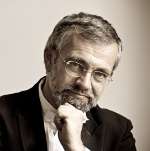Both guest artists of the Sydney Symphony Orchestra’s concerts this week appeared in Australia for the first time: the octogenarian Christoph von Dohnányi and the versatile violinist, less than half his age, Carolin Widmann. The great German conductor must feel a certain pride in his ancestry, as he kept the Hungarian spelling of his surname. And what an ancestry it is, with the brilliant pianist and composer, Ernő Dohnányi, (erstwhile friend and colleague to Bartók and Kodály) as his grandfather, and Dietrich Bonhoeffer, the Lutheran pastor, philosopher and martyr in World War II, as his uncle. Widmann, also German, is equally at home with complex contemporary repertoire and Romantic masterworks; her album of the Schumann violin-piano sonatas with Dénes Várjon is arguably the most convincing interpretation of these works since the iconic recording of Gidon Kremer and Martha Argerich some 30 years ago.
Widmann’s reading of Alban Berg’s last completed work, his Violin Concerto, sounded deeply emotional – almost romantic. Her playing was powerful when needed (for example, in much of the Allegro’s pseudo-cadenza), but also, quietly serene in the appropriate places: for several minutes at the beginning of the first movement, she refrained from vibrating any note, producing a transparently pure sound quality, as she allowed the famous open strings motif and its transformations to soar and decline. These colours may well have been on the composer’s mind when he wrote on the title page: “in memory of an angel”.
Widmann’s musicianship is not showy but rather inward turning, yet her technique is impeccable, ably assisted by her beautiful instrument; on the lower strings, her sound was particularly rich in velvety overtones. Even more appealing was the self-effacing musical intelligence of her interpretation, an attribute that can make a good performance truly memorable. Widmann understands every note in the score and allows that knowledge to be filtered through her visceral musicality. One of the technical difficulties of Berg's Violin Concerto is that, on multiple occasions, the soloist has to play three or four note chords repeatedly – easy enough for a pianist, immensely demanding for a violinist. These passages, for example, in the Pesante, ma quasi a tempo section in the Allegro movement, sounded effortlessly clean and expressive throughout. In Widmann’s performance, every phrase had its meaning and direction (as it was connected to the next phrase and the next after that), without fail, in a clearly defined relationship. Thus it was only natural that she allowed slight fluctuations of time to express the importance of certain phrases and due to this agogic sensitivity, musical shapes emerged in a self-explanatory manner. Dohnányi, himself an expert in this repertoire, followed every nuance with obvious sympathy but did not always manage to keep the orchestra from overshadowing the soloist’s delicate tone. A dozen or so fewer participating string players may have made the balance easier without any compromise to the work. This minor detail notwithstanding, the cooperation between soloist, conductor and orchestra was excellent and Berg’s intricate score radiated with exquisite beauty.
Anton Bruckner’s Symphony no.4 in E flat major, lasting well over an hour, eminently suits a large and highly skilled symphony orchestra like the SSO working with one of the most experienced conductors of the Germanic repertoire. Dohnányi has a profound understanding of the “Romantic” Symphony (Bruckner’s own title). His conducting is reassuringly precise without being pedantic, his beat is clear and bears no nonsense. In this performance, he seemed to concentrate on the large proportions within the individual movements, and to draw sweeping lines rather than being preoccupied with many individual minutiae. While this concept certainly had its own benefits, the orchestra may have gained from more detailed instructions in some places. The first movement’s brassy tuttis were loud but not powerful enough with less depth of colour than could have been expected. The slow movement’s cello theme started hauntingly but the melody lost energy and volume inexplicably before the climactic high C on both appearances of that theme; on the other hand, the famous viola melody in the same movement was superbly executed. The Scherzo’s wild hunting theme would have been more convincing if supported by crisper articulation of the horns. These were individually small issues but in all, they suggested that less than usual artistic risks were taken, which deprived the performance from some of its potential excitement.
The orchestra’s sound was nonetheless focussed and their playing profited from the newly installed amphitheatre-like, tiered platforms which gave perfect visibility to every player and noticeably enhanced the acoustic environment of the Concert Hall.


